
Prionitis sternbergii
Bleachweed
Field observations
Mainly at Botany Bay, Juan de Fuca Strait, B.C., Canada.
4 December 2021, commencing at 4:00pm, as the tide was receding to a low of 0.3 feet at 7:08 pm this evening.
Tide: 4.7 feet at 4:00pm PST (measured at Port Renfrew Tidal Station)
Conditions: Mainly clear with 10% cloud cover, 4˚C, wind light & variable, moderate westerly swell, light chop, humidity 80%.
Moon: Waxing Crescent (approx. 21 hours into this phase at time of interaction); Previous Phase, New Moon, 3 Dec 2021 at 11:43 pm PDT: Next Phase, First Quarter, 10 Dec 2021 at 5:35 pm PDT.
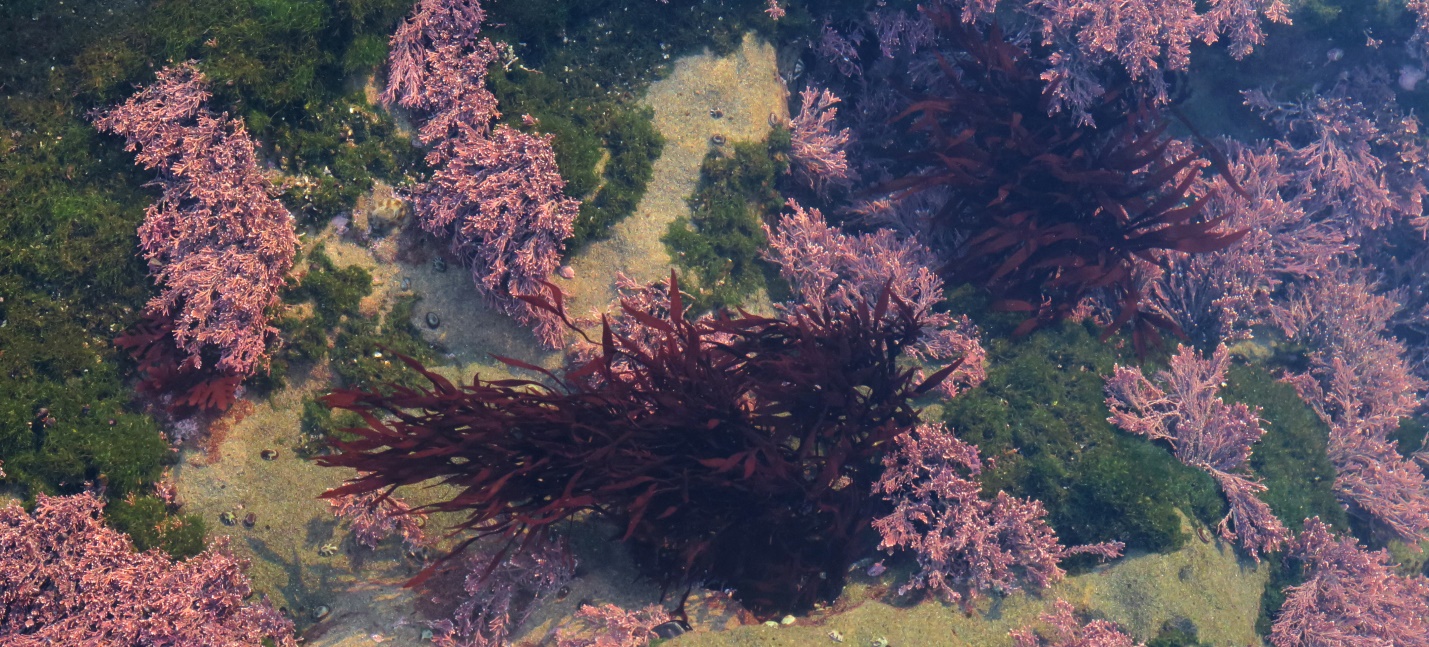
Figure 1: Tide pool home and colorful neighbours for these two Prionitis sternbergii individuals; Botany Bay, Juan de Fuca Strait, BC, Canada. December 4, 2021. Photo ID 27139 ©Seaweedwhisperings.com
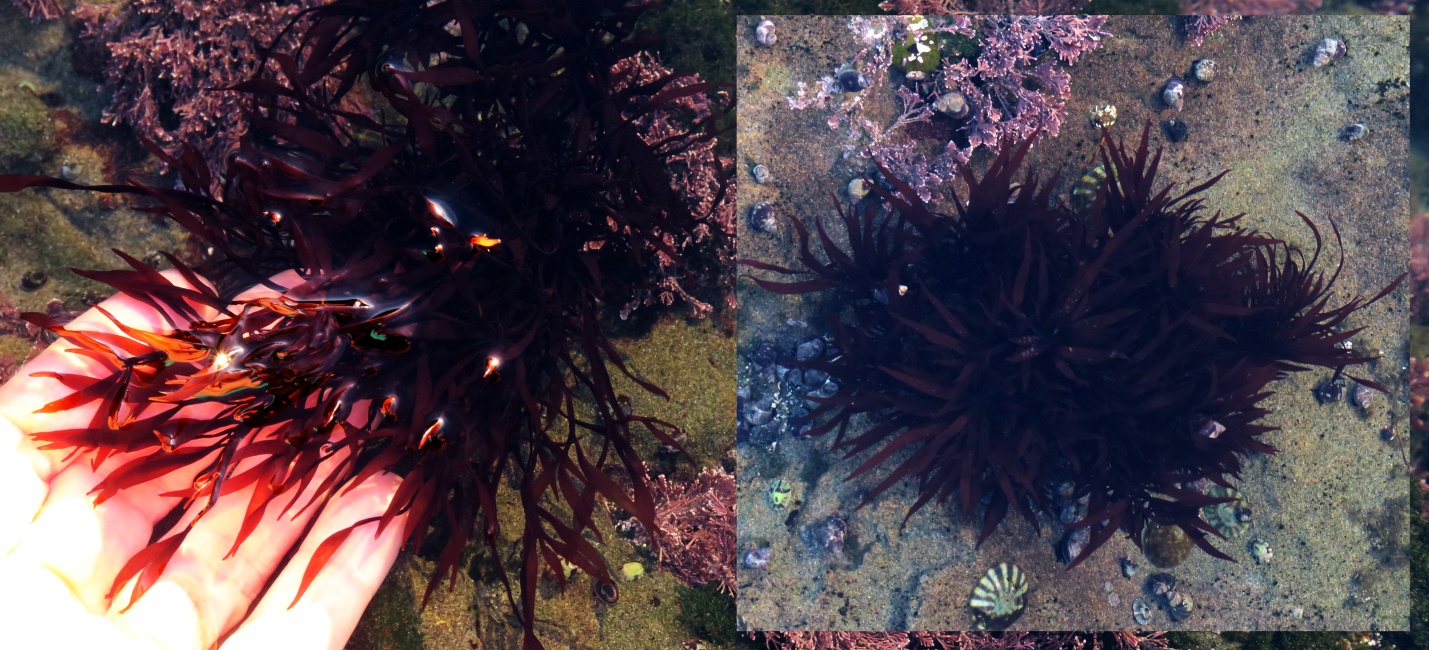
Figure 2 (left): Some bladelets lifted out of the tide pool; the deep red glows in the winter sunlight. Botany Bay, Juan de Fuca Strait, BC, Canada. December 4, 2021. Photo ID 27147 ©Seaweedwhisperings.com
Figure 3 (right): Terminal bladelets spread out radially underwater create an exotic dahlia ‘flower-like’ appearance, Botany Bay, Juan de Fuca Strait, BC, Canada. December 4, 2021. Photo ID 27140 ©Seaweedwhisperings.com
Person 1:
Field observations of Prionitis sternbergii, Bleachweed, were primarily on December 4th but with memories of many past encounters.
Left behind – often the only conspicuous seaweed in shallow, high-ish, intertidal pools.
Forgotten – Lyallii, also lost in the genus Lupinus. Prionitis sternbergii was for many years known as P. lyallii; it is now ‘formerly known’ as Prionitis lyallii.
Many appendages, but not orderly. Makes me think of spiders and crabs.
Person 2’s photo, Figure 4, looks like a medieval dragon motif or caricature. Possibly with many heads and many tongues.
Unapproachable, jagged, unfriendly. Apparent strength is a “bluff”. It’s actually not very strong.
Up close it is very attractive. Gently curving blades emanate from its flattened main axis.
On some specimens, the seaweed bleaches out in places.
There might be hesitancy and uncertainty in its energy. I seem to frequently need to change the wording in my documentation, because I was unsure that I was conveying my thoughts clearly.
It’s a survivor, able to withstand heated tidepools and being sometimes dusted or even smothered by diatoms.
Lonely – sometimes there is only a single Prionitis in a tide pool; it’s not social and perhaps prefers to be alone.
I chewed one piece of this seaweed and noted a crisp texture. Eventually I was able to detect a slight piercing “halogen” flavor. Also I then experienced a bit of tingling on my tongue.
Particularly looking at that one photo, Figure 6, where a whole piece of Prionitis was sitting in Person 2’s palm, it looked very much like a scorpion to me. Thinking of this image in combination with the one I said looked like a dragon, (Figure 4), the concepts of “creepy-crawly” and “fearsome” arose. Then I thought, well, the scorpion is poisonous and the dragon is ‘fire-breathing’ but they retreat; they’re rather fearsome when they’re present but spend most of their time hidden.
Reflecting on the look of this seaweed and dragons, it occurs to me that their beauty is in the intricacy of design. From a distance I see legs, antennae, scales, protrusions all over the place, but when I look closer, I see a beauty. It’s related to an intricacy of design, it’s not simple beauty.
I think this Prionitis is not particularly interested in interacting with me. It’s not pushing me away, but it’s just allowing only so much, as if saying… “Here’s my outer orbital energy”.

Figure 4 (left): Side projecting blades held up for easier viewing, Prionitis sternbergii, Gonzales Bay, Juan de Fuca Strait, BC, Canada. September 6, 2021. Photo ID 27141 ©Seaweedwhisperings.com
Figure 5 (right): A tough perennial, this tide pool resident is doing well. Gonzales Bay, Juan de Fuca Strait, BC, Canada. September 6, 2021. Photo ID 27142 ©Seaweedwhisperings.com
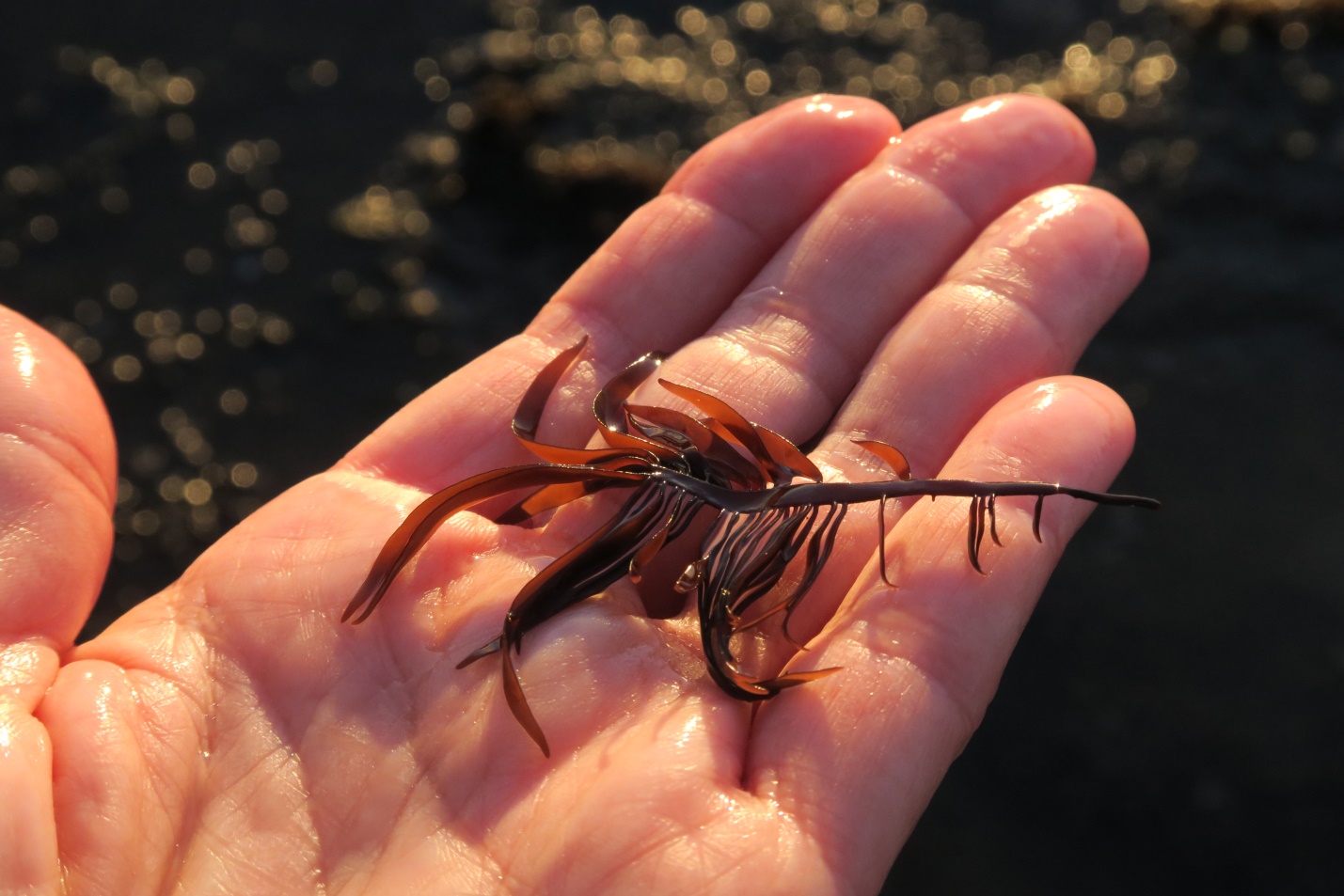
Figure 6: ‘Scorpion’ in hand; Botany Bay, Juan de Fuca Strait, BC, Canada. December 4, 2021. Photo ID 27143 ©Seaweedwhisperings.com
Person 2:
Prionitis sternbergii, we’ve seen you at so many locations over the past year and a half. Today at Botany Bay we observed several individuals growing beautifully in your preferred tide pool habitat. Finally it is time – we’ll engage, with your consent, in an interaction.
“With your consent” – this phrase applies to any respectful energetic exchange, but with you, Bleachweed, it seems even more important – truly essential in fact. You are private; permission must be granted, or I believe we’d understand very little.
You may be pleasing to the eye, and often can be with your lovely deep wine red color a contrast to your neighbors and habitat, but you do not invite close association. I believe you may even repel it.
I don’t think I’ve ever, or only very rarely, seen your blades eaten or even nibbled at much.
Even with your “own kind” you prefer to maintain a ‘stately’ distance. Stately, yes, like a solemn or inscrutable official.
Your outermost bladelets are the longest and taper to a graceful point. There are many of these and they often completely mask with their wavy random or sometime radial arrangement, the pattern of your innermost structure. Inspect the inner (lower) portion of the blade that is closest to the holdfast and there you’ll see a central stem, flat and somewhat broad, that has numerous small bladelets growing on opposite sides. These smaller bladelets can be very short and resemble the ‘teeth’ of a crosscut saw, or when larger, they look somewhat like the rungs up a ladder. Remembering the many individuals I’ve seen at various locations, I now sense an interesting resemblance in this alga’s growth pattern to the foliage of the flowering plant I know as ‘Jacob’s ladder’, Polemonium pulcherrimum.
These teeth or ladder rungs are not the first thing you see when looking at Prionitis sternbergii, except in locations where it is fairly young or regularly nutrient deprived. Possibly hardship pares them down to the basics, and there is nothing left over for the flourishing, curving bladelet growth.
Your deep red coloration has a brownish tint to it. It is almost regal, but it also looks like slightly oxygenated blood. Have you been wounded? Do you cause others to bleed?
When we asked one Prionitis sternbergii alga if we could “pick” one stem for our sensory explorations (taste and smell) we found we had to wait a bit for the response. Prionitis, you didn’t reply with either quick outrage or an easy, “Sure, go ahead”. Instead what came felt like a still and unspoken message – “the consequences will be yours.”
Very little overt communication - Bleachweed won’t guide you to her preferences that way, but she does have her preferences – that is for certain. Prionitis seems to be quite closed down and somewhat sad but also accepting that few can understand her.
In some circumstances, often absence of nutrients, all her “blood” drains away and what is left are “off-white” patches amidst the healthier dark red blades. The plants that have these bleached patches are unattractive to my eye, and it also feels that what has lost color and bleached to off-white will never recover any former color.
Once I settled in to begin this interaction I noticed with a sigh, “Ah, I’m tired.” This tiredness felt unrelated to neither my efforts of the day nor my previous night’s rest. Since I picked this up so clearly and quickly I suspect this bodily tiredness may be the “norm” for Prionitis sternbergii, and especially so for those individuals growing in nutrient poor locations.
Discussion:
So…, what nourishes this seaweed? Many Prionitis sternbergii live in high intertidal pools. On the physical plane, these locations are often nutrient poor. The sun-warmed pools may lose their dissolved nitrogen and other gases, which are not frequently replenished and not every high tide will reach the pools and refresh the physical nutrients.
BUT, what nourishes Prionitis at the energetic level? Perhaps it’s the effortless pleasure of being able to connect with others on a non-physical plane. Adapted to a life where physical nutrients are rarely abundant, perhaps their chief nourishment does not actually originate from the physical realm.
To be sure, there is an aspect of this seaweed’s energy that can be dour and humorless. Attempts at communication with them – questions, suggestions, requests, could often be met with strong disapproval, or at least displeasure, that is expressed more by facial expressions of frowns, scowls, maybe a sighed “humph” than any spoken response or explanation. This if off-putting and dismissive to the one trying to communicate with Prionitis sternbergii. Internally, however, Bleachweed, has an interminable weariness; as a result they don’t want to be bothered to interact and communicate – that simply requires too much expenditure of the energy they are deficient in. They like to rest alone and undisturbed.
Ideally they would possibly like to leave their body at rest and almost exclusively interact energetically, as they recognize and interpret energetic states with ease. They of course transmit or send energy/energetic communication out as well, but this often doesn’t meet up with an able ‘receiver’. Consequently much of the time they are misunderstood. Conversely, the best way for them to receive input/information is also energetically, and again, most people they encounter are still operating at the level of words and gestures, sounds and sights, feelings and emotions. If Bleachweed tries to reciprocate on this level too much of the time, that activity seriously diminishes their strength – draining them of their limited material reserves. It also deprives them of the delight and nourishment that accompanies the pleasure of operating fluidly in their preferred and most natural mode.
Person 1 and Person 2 found the above sections to be a bit difficult to put into words; we had to think carefully to pick the best word where often a perfect word didn’t seem to exist (at least in our vocabulary). We felt a ‘caution’ about how to express this aspect – which probably is exactly the problem Prionitis sternbergii encounters, all day, every day, as they struggle with a mode of connecting via language, spoken or written, that has no direct equivalency to how they experience, express and act in their own self.
The rarity of finding others who can communicate as they do can exacerbate their lonely/alone status. But really, that is evaluating them from a perspective common to those who are comfortable with (and possibly also limited to) spoken language. The thought occurs that Prionitis sternbergii could communicate telepathically. How else to connect with others in geologically separate tide pools! Distance matters not in this scenario and they are therefore not alone!
We are reminded of the principle that stipulates that in order to communicate with another/others telepathically one cannot section off portions of one’s thoughts/memories/mind – that basically one cannot retain secrets. Considering this along with concept of this seaweed’s having the temptation towards or motivation to engage in “illegal or amoral behavior” an interesting paradox arises.
It is very easy to see how Prionitis could be tempted into crime – it is basically a way of ‘cheating’ and gaining much for less effort than ‘legal’ efforts require. When you are living in a nutrient poor area, and often at risk of being nutrient deprived, then gaining ‘easy rewards’ might be worth breaking ‘the law’. However, if one dips into a life of crime, then one is constantly engaged in the need to maintain closely guarded secrets. If Bleachweed opted for a life of crime to meet their physical needs with the least effort expenditure, the secrets and lies and deceptions that accompany that life would very likely block them in their natural mode of connection and expression, thus creating an impairment of their abilities that would bring about intense dissatisfaction, and self-generated discontent. Ill-gotten gains, for sure, no overall gain, the probable result.
Again we see a strong dichotomy here, success on the physical plane for Prionitis can compromise advancement on the spiritual/energetic level. In the overall balance of a healthy ecosystem there often is a place for those who produce less and still have needs for ‘nourishment’ – there would be a pairing up with or a proximity to other life forms that naturally create excess. Some of that excess would be happily taken up by Bleachweed. In such a situation we ponder – when relieved of producing for itself, what does that free up the physically less accomplished Prionitis to be and do?
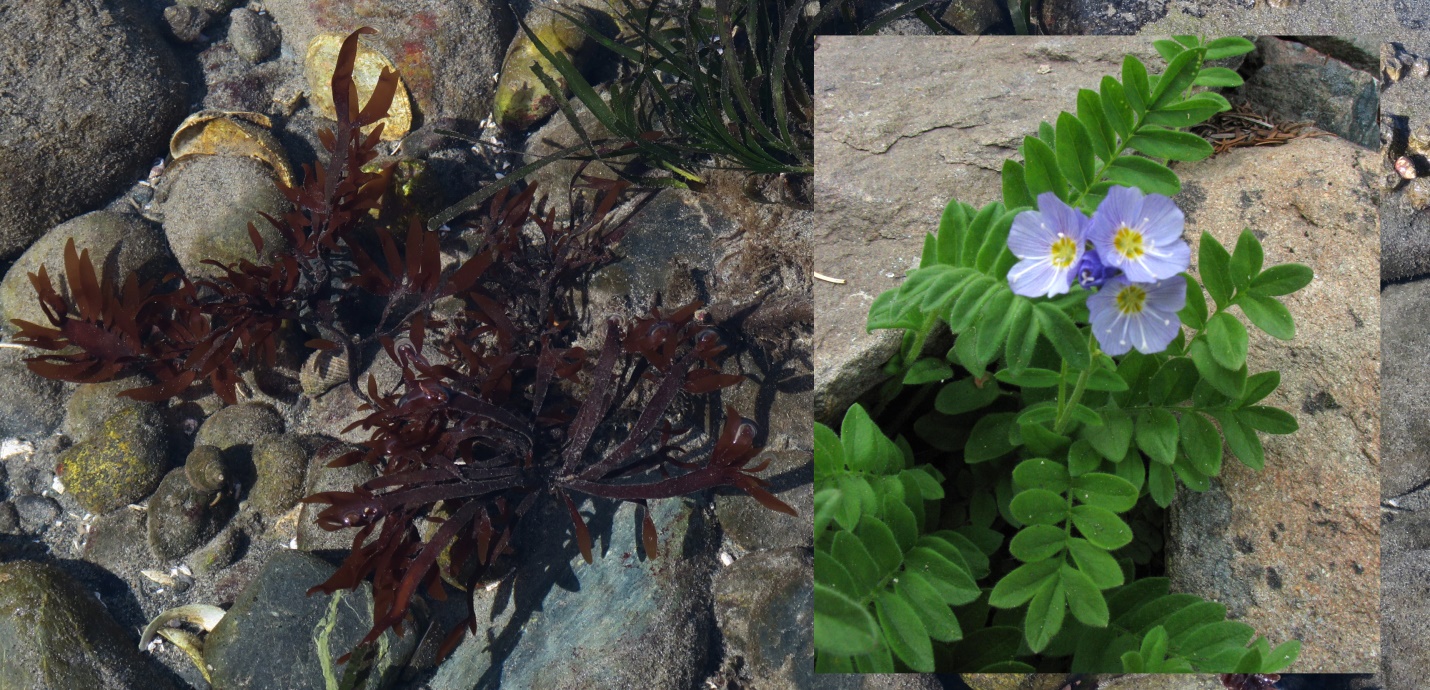
Figure 7: Prionitis sternbergii, 2021 Mar 08, coastline at Jordan River, Juan de Fuca Strait, BC, Canada, March 8, 2021; and (inset), Polemonium pulcherrimum, Olympic Mountains, Washington, USA, July 22, 2006. Photo ID 27144 ©Seaweedwhisperings.com

Figure 8: An example of the different morphology of this red alga. Snuggery Cove, Port San Juan, BC, Canada. December 4, 2021. Photo ID 27145 ©Seaweedwhisperings.com
Person 2’s second immersion:
We’d left this interaction knowing it was not yet complete. We’d return to it later, when the time was right. Person 2 awoke early a few days later and Prionitis sternbergii was present, willing to connect.
The first aspect that came up is the duality of messy & random versus a patterned look.
Then came the thought that there may be poor physical recovery ability in this seaweed; parts bleached do not feel like they can be restored, replenished, revitalized, returned to their former healthier deep red wine color.
Another kind of contrast came to mind; this red alga lives often in the high intertidal zone, so the place that can be “high and dry” and that also has the greatest change in temperatures and salinity, but it also finds its niche actually in water, albeit the shallow waters of tide pools. You could say that it lives in tiny isolated pockets of the sea. And if the tide pool is a larger one, Prionitis sternbergii will be in the regions near the surface at areas that would receive the most light. So, you find your water, you find your light and you do it differently, Prionitis, and in the fringes. Are you not able to compete or are you unwelcomed in more popular areas?
Bleachweed, you seem to be past the point of being disgruntled with your lot in life, your circumstances which clearly are not the easiest. You’re matter-of-factly doing, quite simply, the best you can with what you’ve got.
You can be quite stolid, mainly unflappable (enduring rising water temperatures and routine shortages in nutrient supply) and while you don’t indulge much in outward displays of emotion, there is just the touch to you of an air of the “long-suffering”.
You have the quiet courage that underlies fortitude, you handle adversity and you are rather ‘distant’ in your involvement with life – it is a kind of “abstaining from” that characterizes you.
You don’t give many indications of what is going on inside you but you cannot completely hide the taint of disappointment that you bear.
It is as if in your shallow-watered rock-rimmed tide pool, you often bump up against sadness and displeasure about the parts of your life where hopes and expectations were not fulfilled. This is one side of you, and like the “messy” has its balance in the “patterned”, within your experience there is not only disappointment but also satisfaction, happiness or even deep contentment. But to “see” this in you, Prionitis sternbergii, one needs to look with a different kind of “eye”.
This side of you often pertains to that which is very private and most personal. The concept that pertains here is expressed in the expression – “between me and my God”.
So, Prionitis sternbergii, most others choose to leave you alone. Your personality does not invite close interaction and this suits you well as those who interest you, those who meet you where you are at, are few and far between. You can wait, you will endure and abide until and if such another comes along.
I reflected a bit on the similarity I saw to the flowering plant known as Jacob’s ladder. I can recall from my young childhood years hearing a hymn sung which had repetitions of lines including “we are climbing Jacob’s ladder” and “every round goes higher, higher” but I was unclear on the symbolism of this ladder. A quick study revealed that the Ladder of Jacob symbolizes the connection between Heaven and Earth. It represents progress, ascension and spiritual passage through the levels of initiation. In the bible, Jacob’s ladder established contact between man and God, and there are seven rungs on the ladder of virtue.
It is remarkable to consider this “ladder” in the context of the qualities this seaweed exemplifies. With chronic low energy any measure of vitality and physical stamina and strength on the physical realm is, indeed, very low; it is lower than bankruptcy and surrender. It is at the point of almost materially ceasing to be, near the ending, and often includes condemnation and being outcast. In the spiritual aspect of life, however, could it be that this seaweed is very nearly about to ascend? Could it be that their passage up the steps of the ‘ladder’ is practically complete.
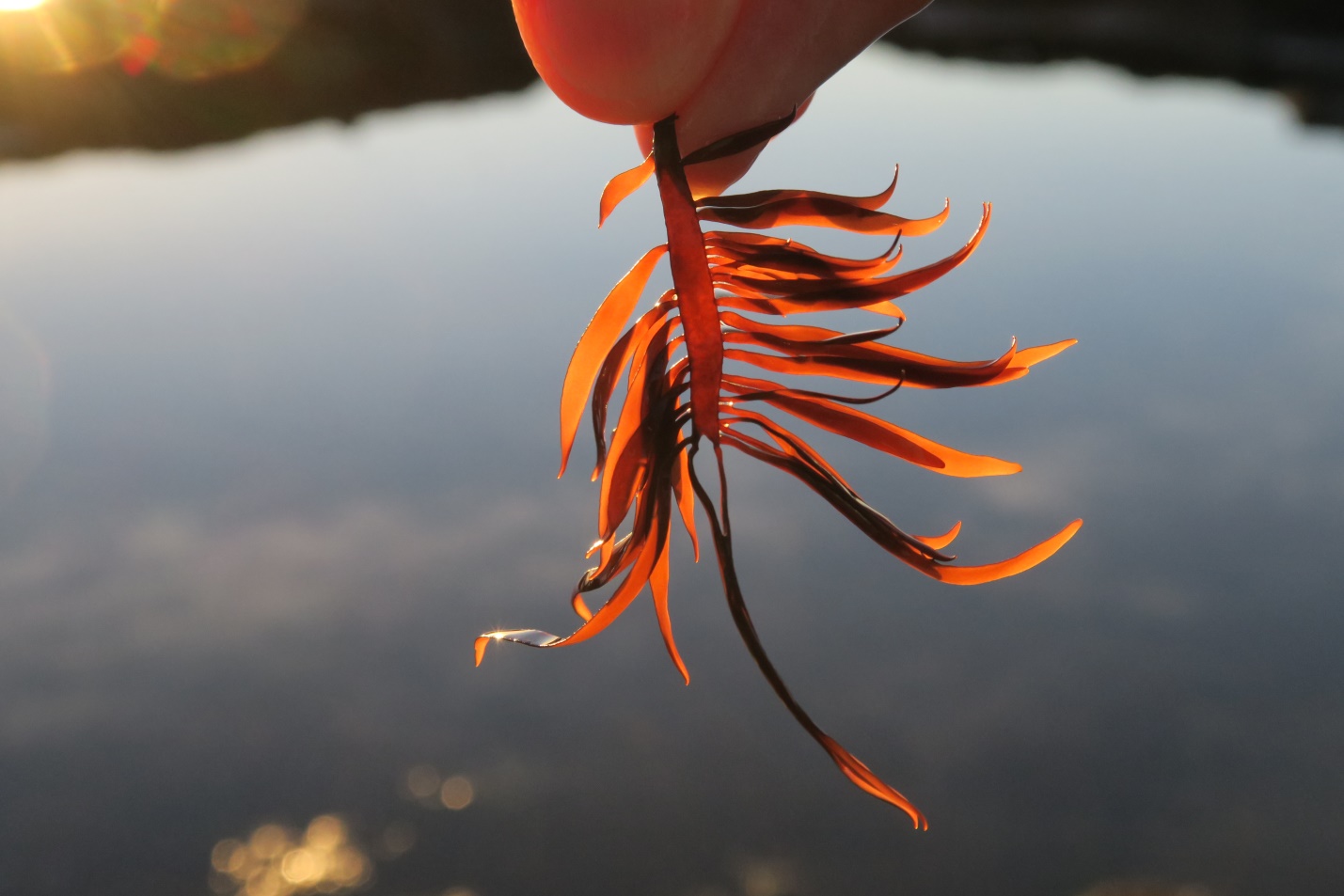
Figure 9: Ladder to the light. Botany Bay, Juan de Fuca Strait, BC, Canada. December 4, 2021. Photo ID 27146 ©Seaweedwhisperings.com
Biology & Natural History Information:
Description:
This perennial red alga has a flattened and rather thick and tough thallus that ranges in color from yellowish or caramel brown to dark reddish brown and even deep blackish brown and grows to 40 cm in length. With darker individuals the color can ‘bleach’ to yellowish brown or off white, and the seaweed itself emits an odor similar to bleach when crushed or torn. The main stem/axis varies in width but is distinctly strap-like; numerous lateral branches grow from both sides. Nearest the base these branches are like small narrow teeth, but they enlarge to longer and narrow pointed bladelets further along the stem. This species can be morphologically quite diverse, its form varying with geography and other conditions.
Habitat:
Prionitis sternbergii grows on rock from the mid intertidal to the upper subtidal regions of semi-protected to exposed habitats. It is also a common inhabitant of tide pools.
North Pacific Distribution:
Southern Alaska to Baja California, Mexico.
Remarks:
Redder forms of this species grow in the lower intertidal region which is subjected to more wave action and therefore increased nutrients. In tide pools or very quiet waters, individuals may look almost yellowish in color. The bleach odor when crushed is thought to be a chemical defense against grazers.
Classification:
Phylum: Rhodophyta
Class: Florideophyceae
Order: Halymeniales
Family: Halymeniaceae
Genus: Prionitis
Species: Prionitis sternbergii (C.Agardh) J.Agardh 1851
Previous name(s): Prionitis lyallii
![]()